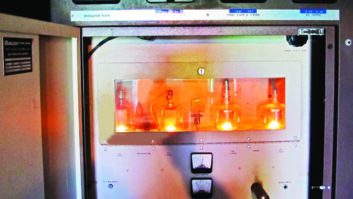If you were to list the most common trait among broadcast engineers it would be our unending quest to learn more.
However, other than a few books, seminars or tech manuals, the resources may seem somewhat limited — especially with the graying of many in this profession.
Thanks to the Internet, as well as the efforts of today’s consulting engineer community, a variety of papers and tutorials are available.
One such place to quench this thirst for knowledge is the Web site of Seattle-based Hatfield and Dawson, www.hatdaw.com. If you’re into AM, you’ll find the site chock full of practical information.
(click thumbnail)Proper mounting and orientation of Austin Ring Transformers, courtesy of Hatfield and Dawson.One of the firm’s principals, Ben Dawson, called my attention to an installation drawing for Austin Ring transformers, after reading about Stu Engelke’s VSWR trip problem in the Jan. 2 issue.
Ben points out that proper orientation of the spark-gap balls is only part of the story. Installation of the transformer so that the secondary can create rain drips to the primary will eventually cause a spot where the next big lightning hit will find a home.
This situation and solution are best illustrated in Fig. 1, prepared by the firm’s draftsman, Bob Allen. The drawing can also found at www.hatdaw.com/papers, under Austin Ring Transformer Installation.
Ben says it’s not uncommon, particularly out in the temperate rain forest of Washington state, to find an Austin transformer failure that is clearly the result of years of drip erosion.
Add to the drip erosion the fact that if the balls are mounted vertically, the arc won’t self-extinguish. Mounting them horizontally makes a situation like a “Jacob’s ladder” so that the heat of the arc causes it to rise and (hopefully) self extinguish.
Ben recollects that a FEMA installation in the Midwest had such vertically mounted arc gaps which reportedly resulted in a total loss transmitter fire.
* * *
Brentwood (Bud) Bailey spent 40 years as an AM engineer in Ohio, working with WICA, WREO and WFUN.
Now retired, Bud also weighed in on the Austin Ring transformer dilemma. He writes that after 40 years, he hasn’t seen everything but he’s seen a lot!
He too points out that improper positioning of the rings can also cause icicles to form between the bottom of the upper ring and the inside of the lower ring in colder climates. The result can not only put the station off the air, but damage the transformer when an arc develops and burns a hole in the lower ring.
It was Bud’s experience that the transformers be kept painted with an insulating paint to prevent moisture from penetrating the fabric and short out the windings. Check the integrity of the painted fabric covering the windings as part of regular tower inspection.
* * *
It seems the entire country felt the New England chill this winter. Contract and project engineer John Ramsey offers a reminder for those building transmitter plants: provide a source of supplemental heat.
This is especially important in a day of solid-state transmitters that put out less heat.
A few years ago when John moved one of his AM clients to a new site, he added a 5 kW electric heater, just in case. John did this even though the station was a 5 kW operation going 24/7 with a full-power backup.
The heater sat unused until recently, when the station suffered a power surge that caused severe damage to both transmitters. It took the better part of a day to get the station back on the air. During his time at the site, the outside temperatures hovered in the teens and the building temperature was 45 when he arrived.
(click thumbnail)RSI offers RF safety classes.
The heater kept John comfortable and safe.
When the transmitter building is that cold, it’s easy to make mistakes as you try to stay warm. A heater can also fight condensation, which can form if the transmitter warms up too quickly.
* * *
(click thumbnail)Transmitter gremlins do exist.RSI, a company that offers RF and technical safety training, is bringing its RF Site Safety and Awareness seminars to Hershey, Pa., and Albany and Buffalo, N.Y., in April.
The university-based training focuses on both OSHA and FCC policies as well as RF and general safety issues.
Call (888) 830-5648 to reserve a seat or register online at www.rsicorp.com.
* * *
Greg Muir is the chief for Cherry Creek Radio and the Central Montana Radio Network in Great Falls, Mont. There are times he has to go out, in the middle of the night, to help an old ailing transmitter that has gone off the air.
As seen in Figure 3, Greg feels there is more behind the problems than simple component failure. Finally we caught one on film. So that’s what a gremlin looks like!










